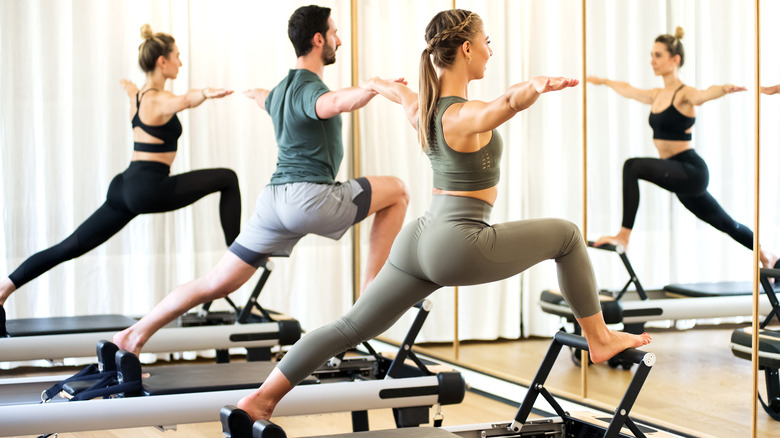The Pros And Cons Of Competitive Group Fitness Classes
For many people, working out in a group is a preferred way to exercise. Whether it's a spin cycling class, combat training, or an outdoor HIIT workout, options abound. But it can be difficult to decide which type of group class is right for you. Knowing the pros and cons of competitive group fitness classes can help you make an informed decision.
Before we get to that, let's examine what draws us to working out with other people in the first place. By now we all know that fitness is crucial for a healthy lifestyle. An exercise buddy or group can motivate us and keep us exercising consistently, according to the Centers for Disease Control and Prevention (CDC). In fact, there's research that shows we're influenced by the exercise behaviors of those around us, per a study published in the Journal of Social Sciences. Another study published in the journal Obesity found that overweight people tend to lose more weight if they spend time with their fit friends — the more time they spend together, the more weight they lose.
Group fitness enthusiasts commonly credit social support as the reason they return to their favorite classes. But it turns out that competition may be a bigger factor. According to a study published in the journal Preventative Medicine Reports, competition motivated participants to exercise overwhelmingly more than social support (via Medical News Today).
The downsides of group fitness classes
If you're competitive by nature, a competitive group fitness class might just be your speed. But your personality type needs to beware of burnout. According to VeryWellFit, burnout happens when you're constantly trying to win, beat another person, or when you overly compare yourself to others. These habits can infringe on other parts of your life. In particular, if you find yourself comparing your body to someone else's or believe that success is dependent on your body, competitive group fitness classes might increase a sense of dissatisfaction or worsen symptoms of body dysmorphic disorder (per VeryWellFit). If you think this could be the case, talk to your doctor before signing up for a competitive class.
Another downside of competitive fitness classes is injury brought on by poor form or overexertion. "One of the biggest issues I've noticed is assumed levels of fitness," John Ford, certified exercise physiologist and owner of JKF Fitness & Health, told NBC News. Ford notes that many of the moves that commonly come up in classes (such as squats, lunges, bent-over rows, etc.) require core strength, strong stabilizing muscles, and mastery of proper technique in order to safely perform them. A 2015 review in Injury Epidemiology found that 36.2% of workout-related injuries were caused by overexertion and 35.9% were associated with group classes.
The pros of group fitness classes
Downsides aside, there are plenty of benefits to participating in a competitive fitness class. Working out with even one other person pushes you to perform better and increases your motivation gain (via NBC News). One study published in the Journal of Sport and Exercise Psychology tested this idea and found that participants who did plank pose with a more fit exercise partner upped their planking time by 24%. But, that's not all.
Group exercise classes can improve your self-esteem and help you reach your goals faster (per VeryWellFit). The competitive environment can fuel not only your body but your mind, helping you stay motivated during class and even outside of it. In fact, doing a fitness class can help increase intrinsic motivation. According to Frontiers in Psychology, group exercise can help regulate intrinsic motivation because of competition and a set fitness routine. At the end of the day, deciding if a competitive group fitness class is right for you boils down to your personality, your budget, what factors motivate you, any health conditions you have, and your goals.



